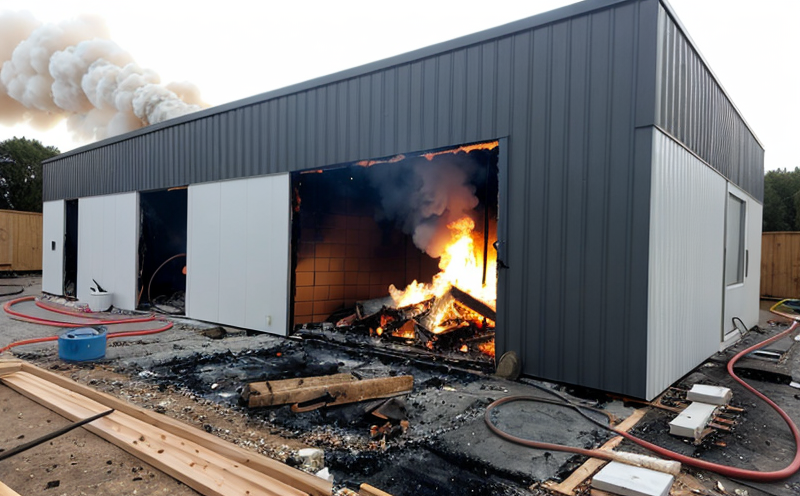EN 1364-4 Fire Resistance of Non-Loadbearing Cladding
The EN 1364-4 standard is pivotal in evaluating the fire resistance performance of non-loadbearing cladding systems used in buildings. This test is mandatory for ensuring that building materials and components can withstand the rigors of a simulated fire environment, thereby protecting occupants and infrastructure from potential hazards.
Non-loadbearing cladding systems are typically installed on the exterior or interior walls of buildings to provide aesthetic appeal, thermal insulation, or additional structural support. However, their primary function is not load-bearing; they remain secondary to the main building structure. Given this role, it’s critical that these components meet stringent fire safety standards.
The test method described in EN 1364-4 involves placing a sample of cladding material between two horizontal supports and subjecting it to controlled exposure to a standard fire source. The duration of the fire is set at 90 minutes, which is designed to simulate real-world conditions that a building might encounter during an emergency situation. During this period, various parameters are continuously monitored, including temperature rise within the specimen, flame spread behavior, and structural stability.
The objective of this test is not only to assess the immediate fire resistance but also to ensure long-term durability under extreme heat. By adhering to these standards, manufacturers can guarantee that their products meet regulatory requirements and contribute significantly to public safety.
For quality managers and compliance officers, understanding EN 1364-4 is essential as it directly impacts product development and market entry strategies. R&D engineers benefit from this knowledge by optimizing material selection and design for enhanced performance. Procurement teams can leverage these insights to source high-quality materials that meet stringent fire safety standards.
The test procedure involves detailed specimen preparation, precise instrumentation calibration, and comprehensive data recording. The process is meticulously designed to replicate real-world conditions as closely as possible, ensuring accurate and reliable results.
Real-world applications of EN 1364-4 include residential buildings, commercial structures, hospitals, schools, and other public facilities where fire safety is paramount. Compliance with this standard helps ensure that these essential services remain operational even in the event of an emergency.
Industry Applications
Table 1: Specimen Preparation Requirements
| Specimen Dimension | Material Type | Preparation Method |
|---|---|---|
| 1000 mm x 500 mm x 25 mm | Non-loadbearing cladding materials | Cut to size and ensure flat surface |
| 2000 mm x 1000 mm x 25 mm | Supporting materials for fire resistance test | Prepare as per standard specifications |
List of Common Fire Sources Used:
- Bunsen burner
- Electric radiant heaters
- Gas-fired burners
The test results are crucial for various stakeholders, including architects, contractors, and regulatory bodies. Architects can use these results to design safer buildings, while contractors ensure compliance during construction. Regulatory bodies rely on this data to enforce safety standards effectively.
Why Choose This Test
The EN 1364-4 fire resistance test is a critical component of any quality assurance program for non-loadbearing cladding systems. It provides a standardized method for assessing the performance of these materials under controlled fire conditions, offering peace of mind to all involved parties.
By choosing this test, manufacturers gain several advantages:
- Enhanced product reputation: Meeting stringent standards boosts brand value and customer trust.
- Regulatory compliance: Ensures adherence to international regulations, facilitating easier market entry in different countries.
- Improved safety record: Demonstrates a commitment to public safety, reducing the risk of liability issues.
The test results are not just numbers; they represent a tangible contribution to safer buildings and communities. This makes it an indispensable service for any organization involved in the design, manufacture, or inspection of non-loadbearing cladding systems.
Competitive Advantage and Market Impact
Meeting the EN 1364-4 standard provides significant competitive advantages:
- Enhanced product differentiation: Standing out in a crowded market by offering superior fire safety features.
- Premium pricing potential: Justification for higher prices based on enhanced safety and performance.
- Better customer satisfaction: Assurance that the products meet or exceed international standards, leading to increased customer loyalty.
From a market perspective, compliance with this standard can open doors to new markets and partnerships. It also helps in building long-term relationships with clients who prioritize safety and quality.





